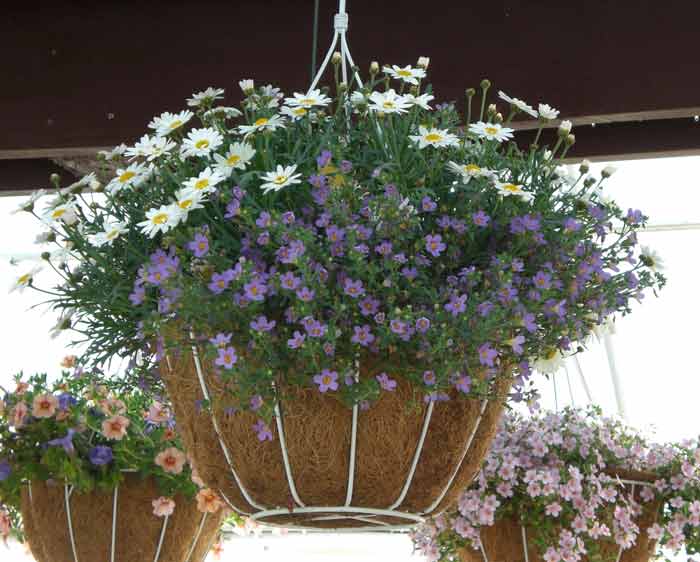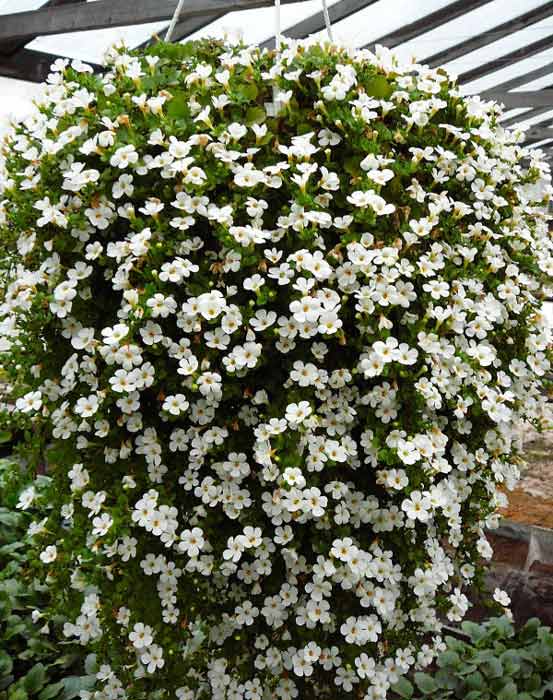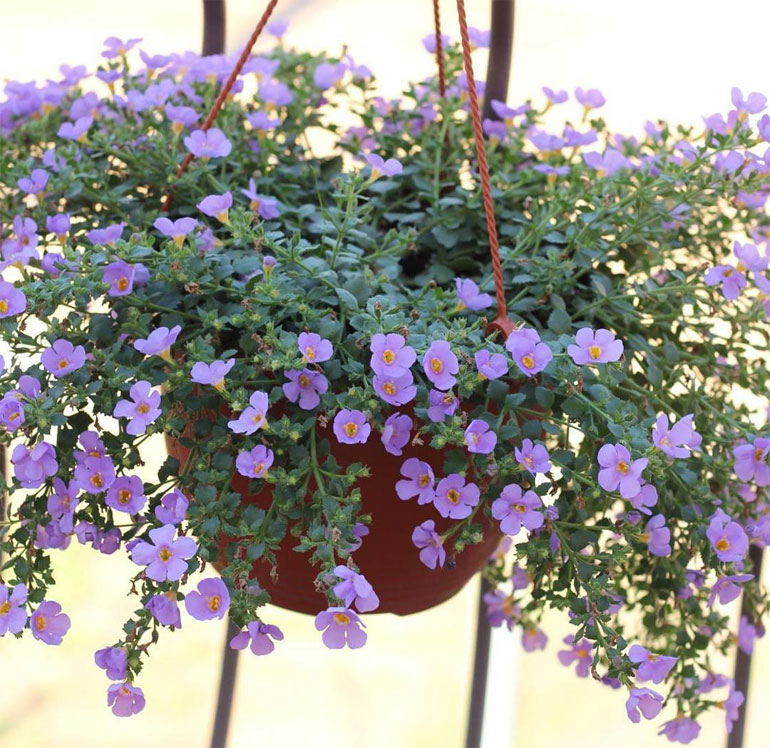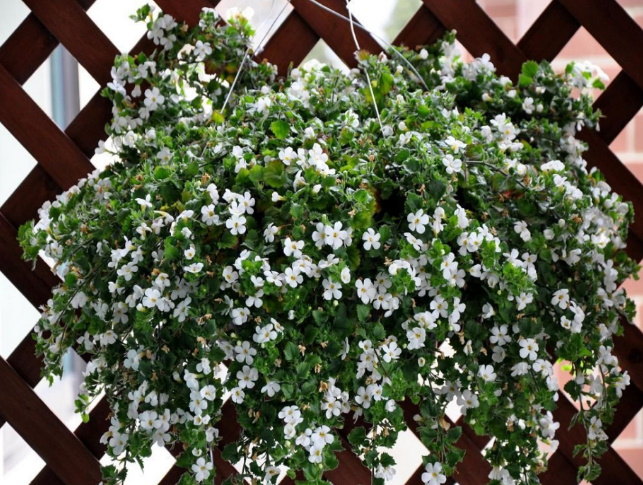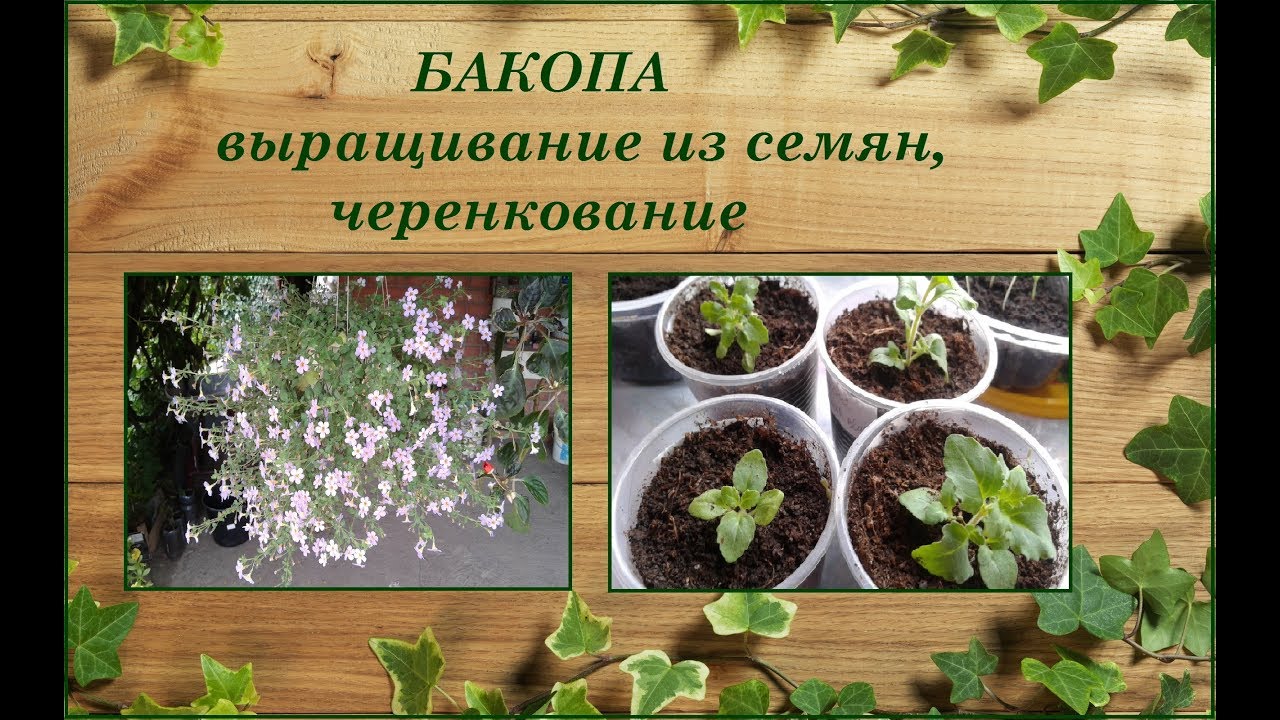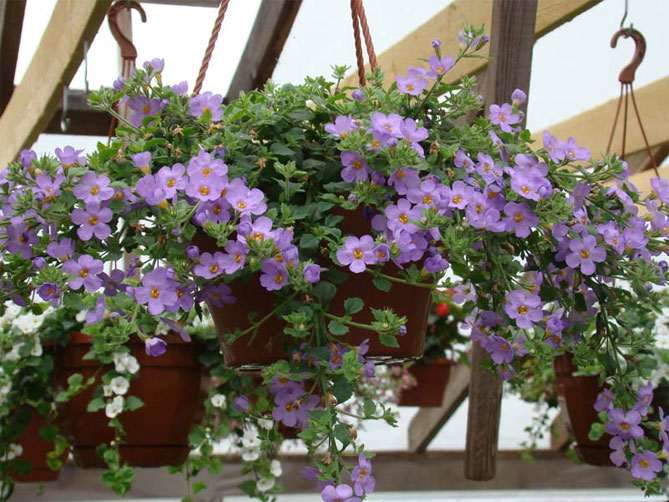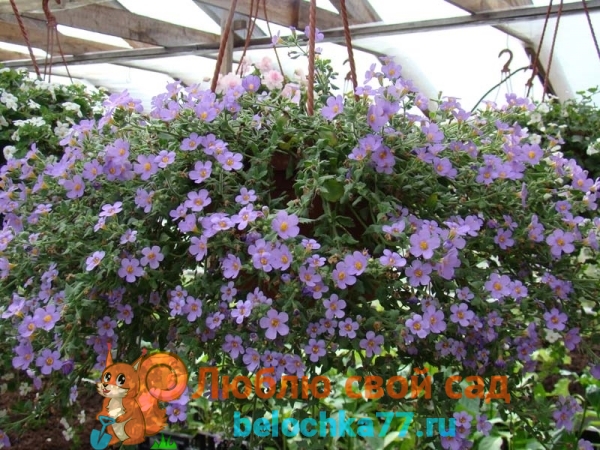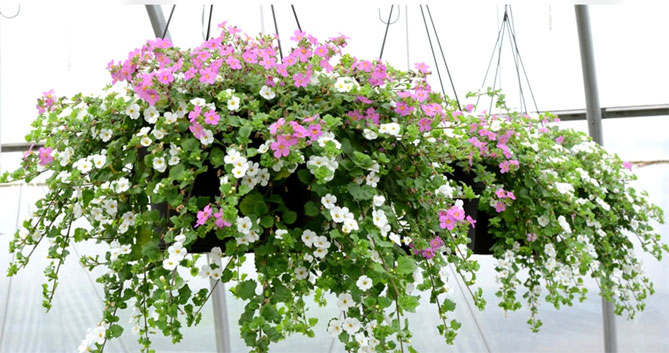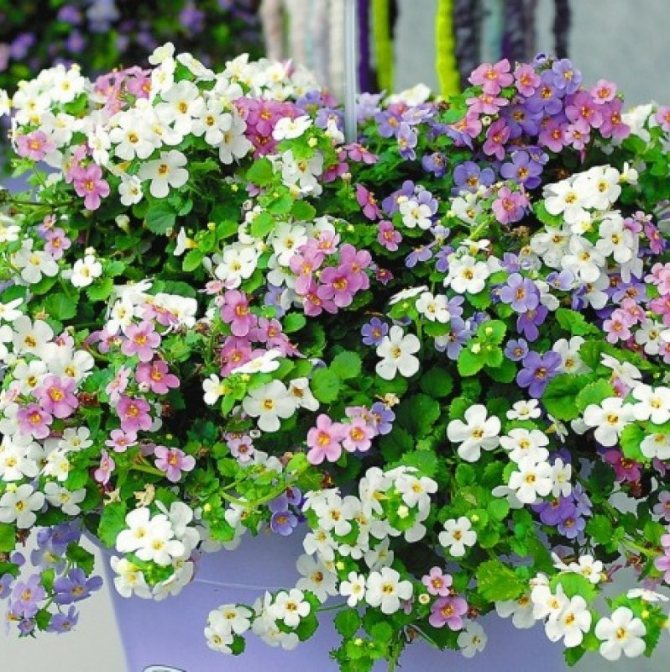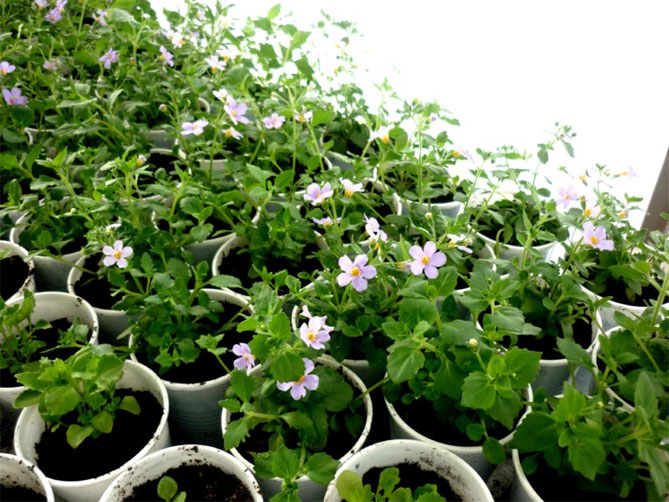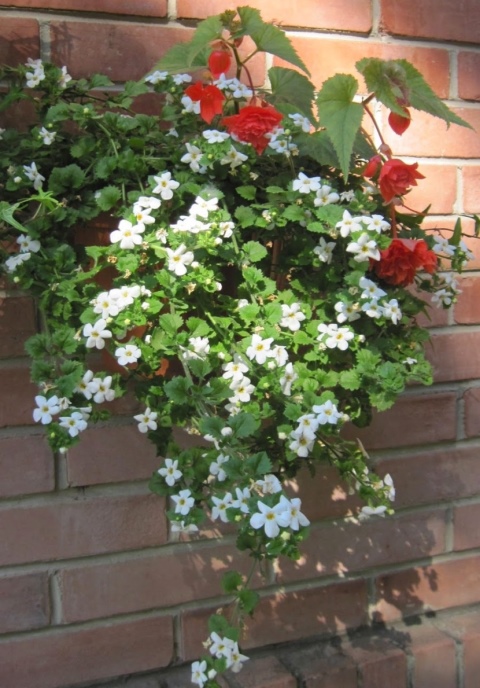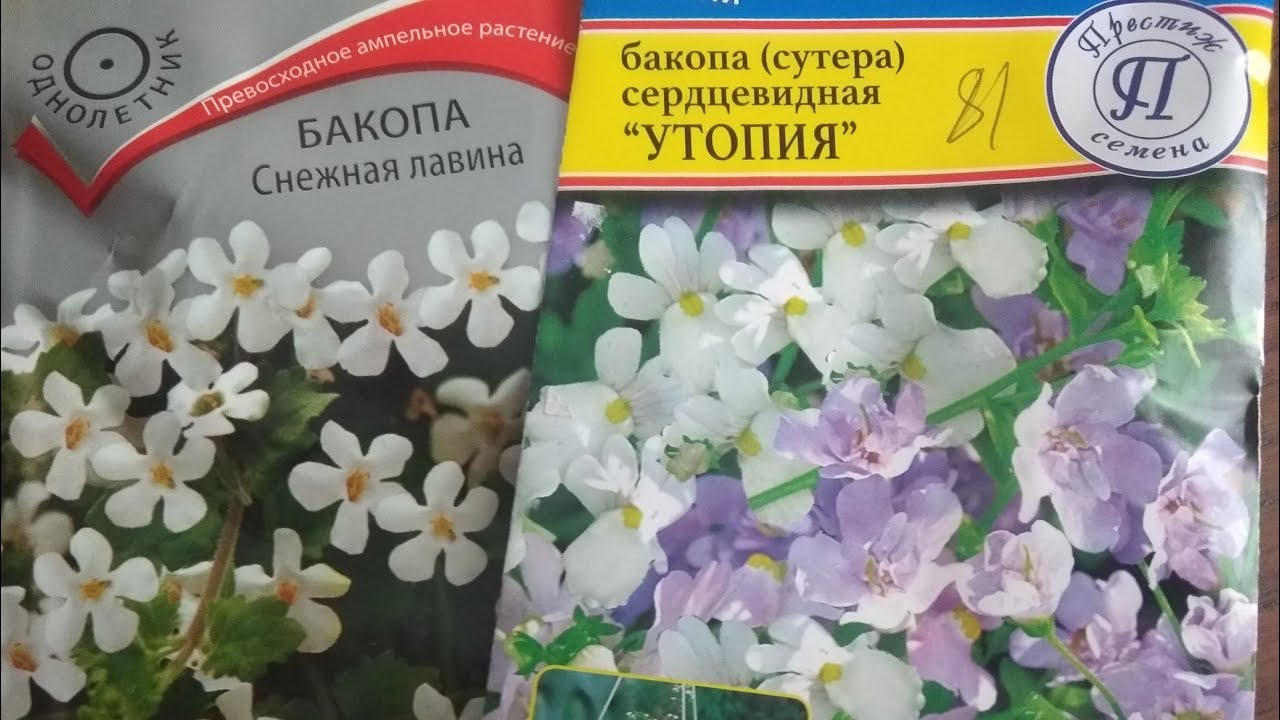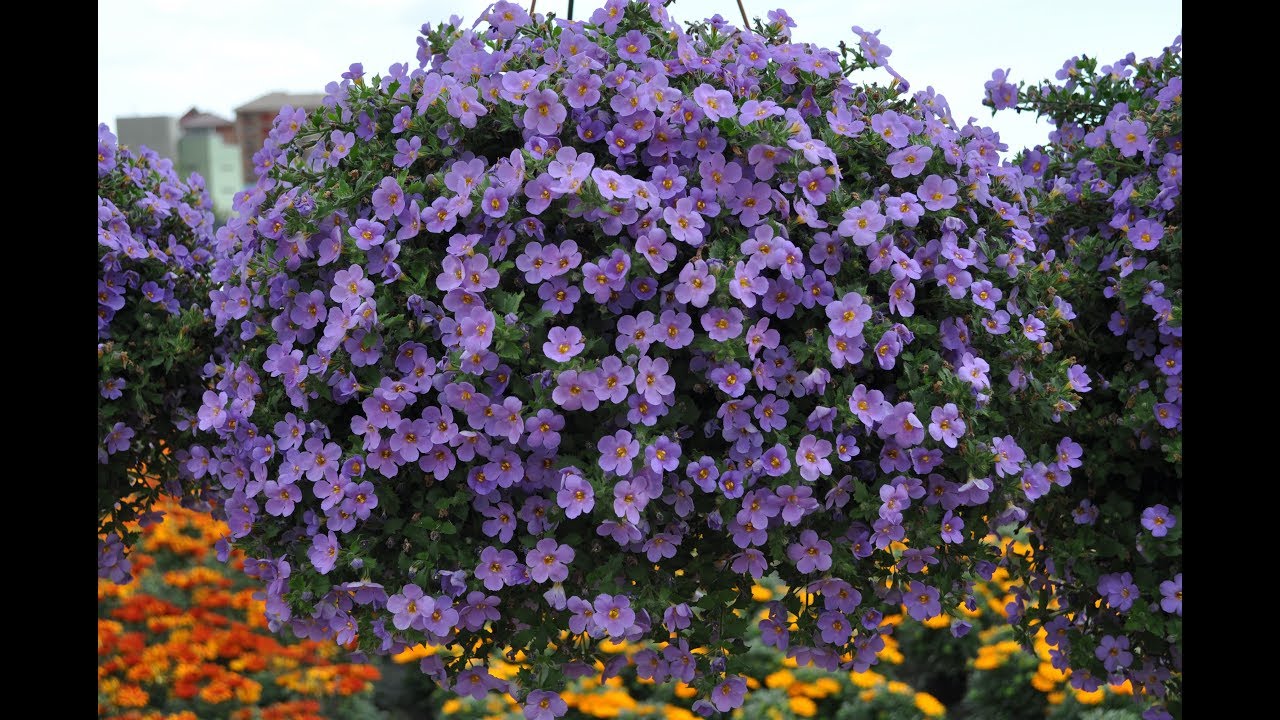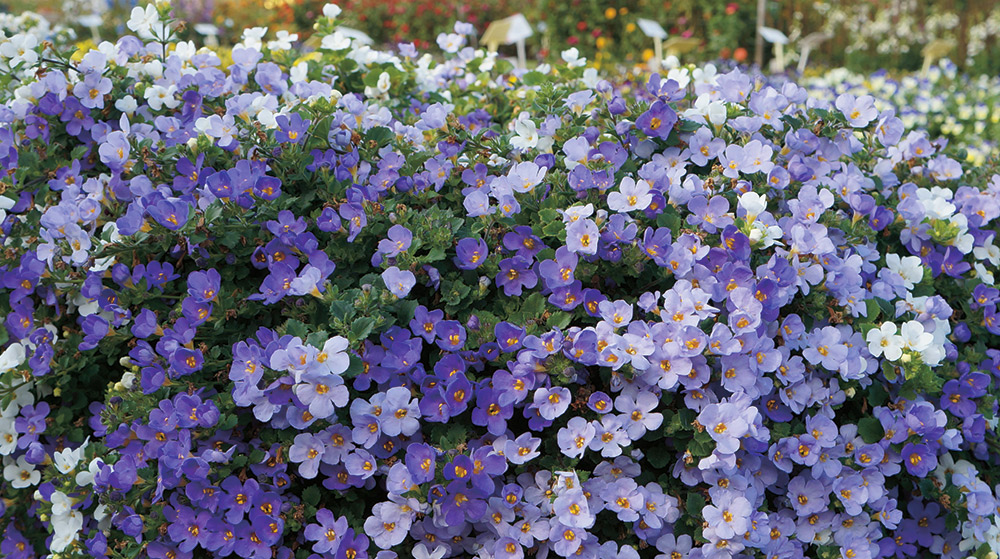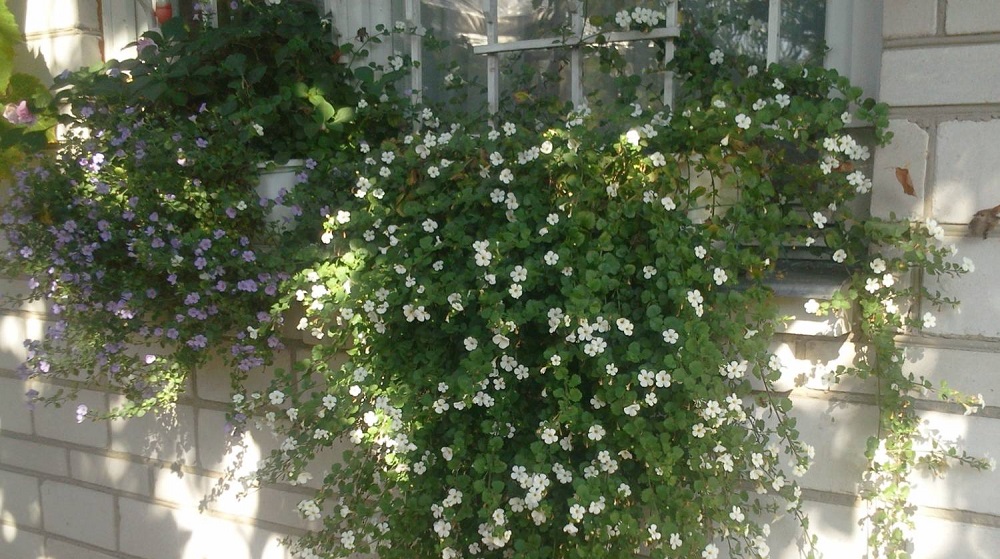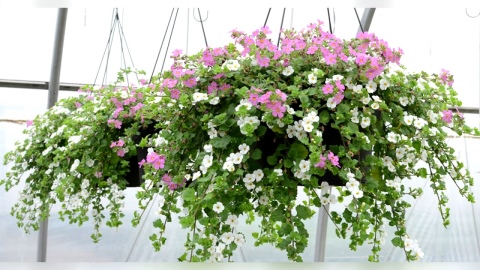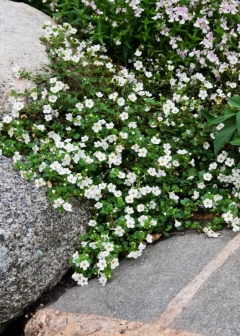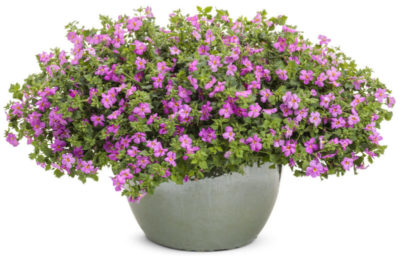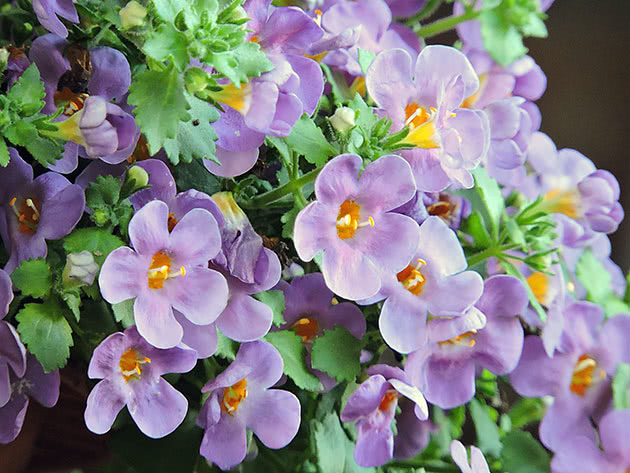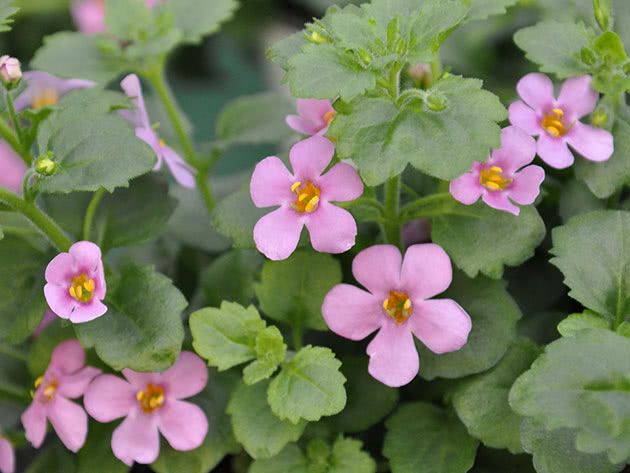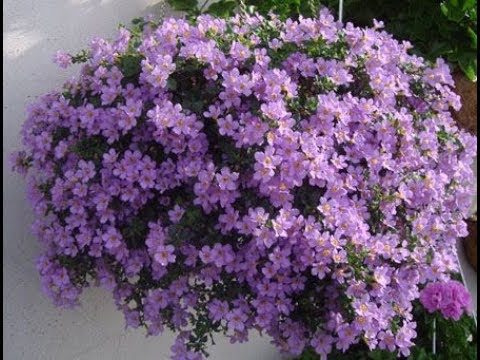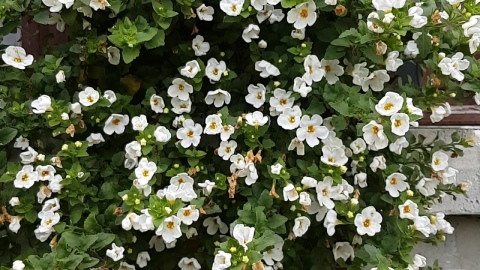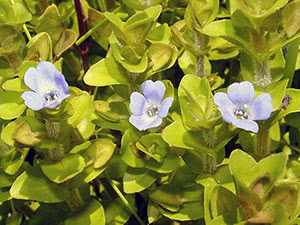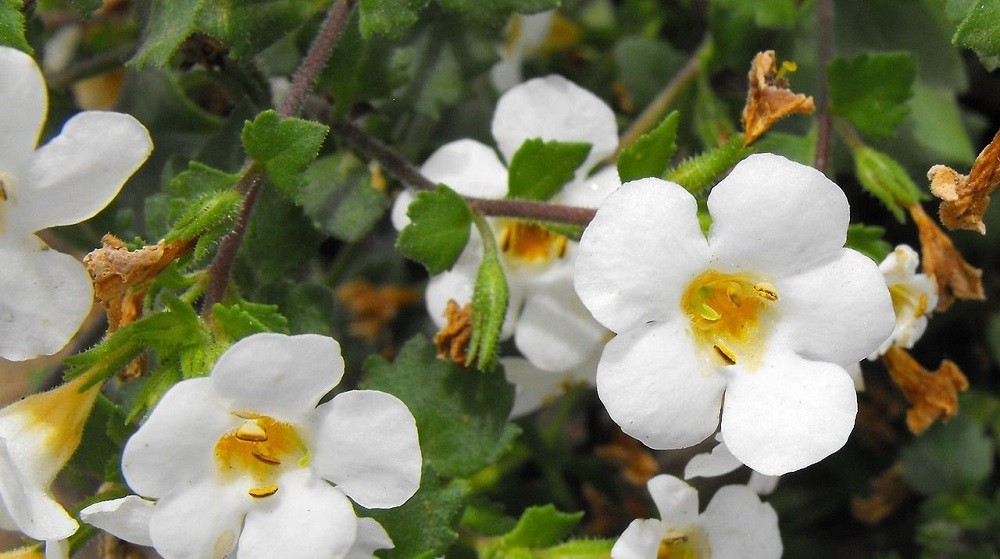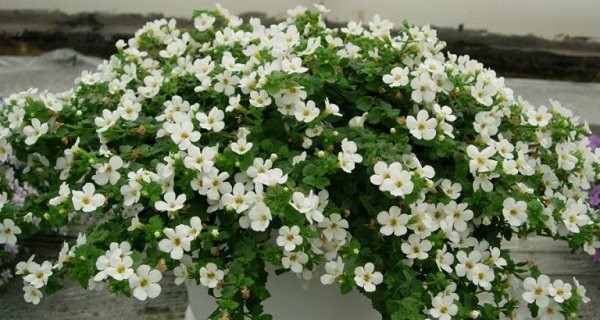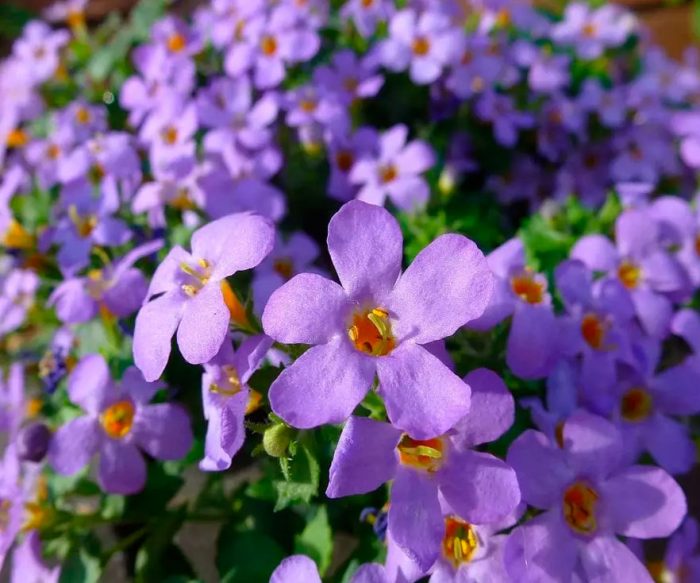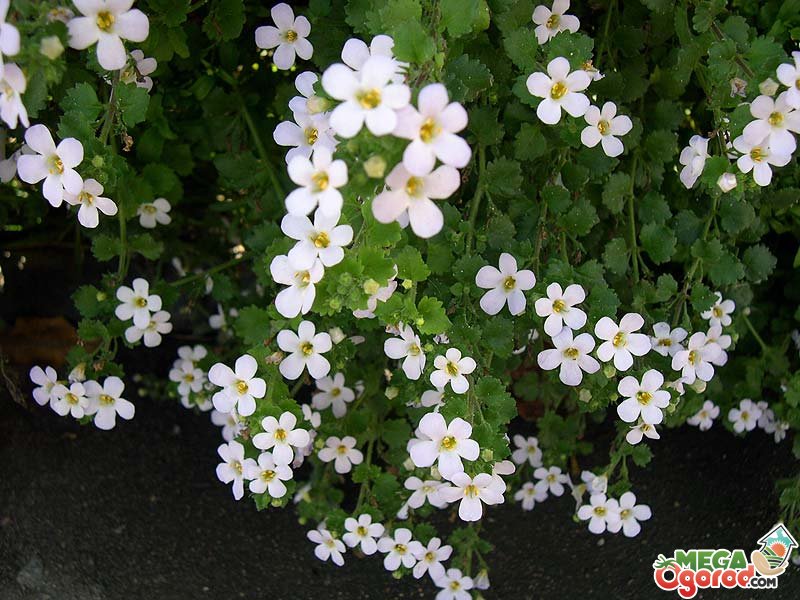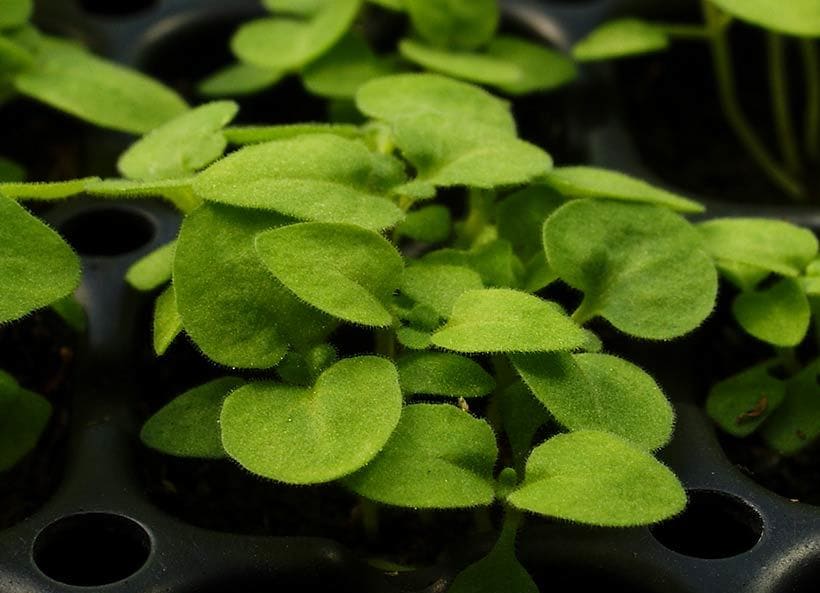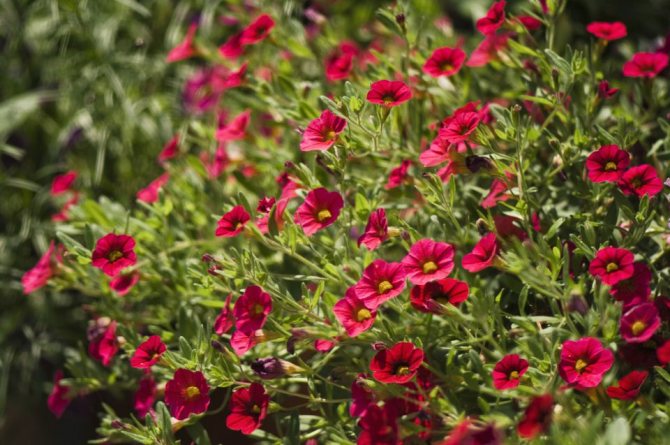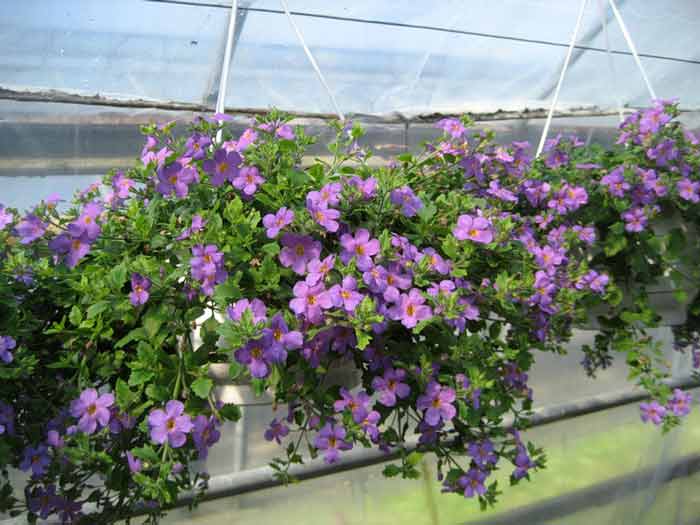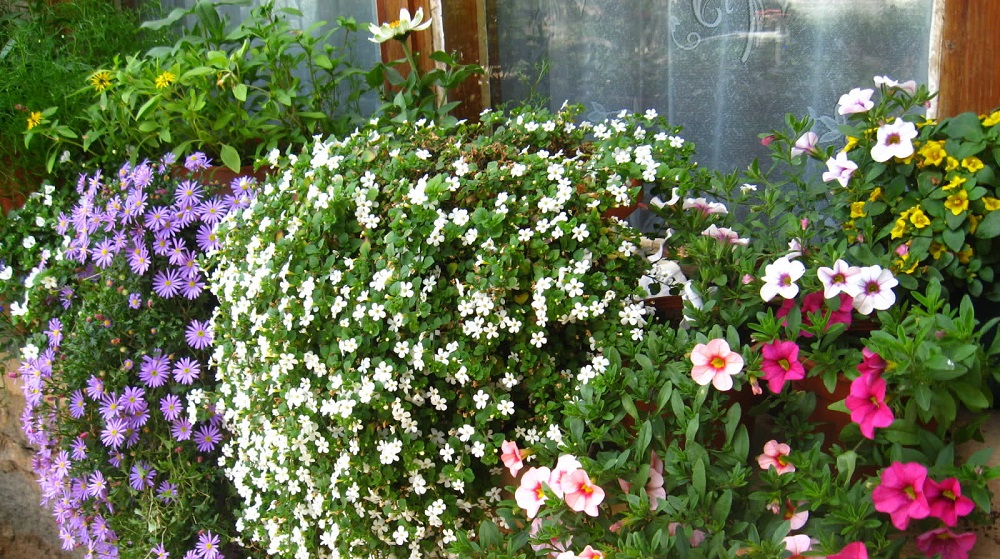Description and varieties
Bacopa is a herbaceous perennial plant with thin, creeping or lodging, creeping stems. Shoots in length can reach 0.6-0.7 m, bush very strongly and grow in breadth. Small rounded or oval leaves sit in pairs, have a bright green or olive-greenish color. The leaf blade has small notches along the edges. Fast-growing foliage forms a very lush head.
Flowers are usually small, bell-shaped axillary or tubular, but they can be large. It all depends on the varietal affiliation of the plant. Plain or double flowers have a wide variety of shades of blue, pink, blue, lilac, purple, lilac and white. The flowering process is long, but wavy in nature. In the first wave, the sutera is almost completely covered with lush foam from the buds, which fall off on their own at the end of flowering, thereby helping the flower to always have a neat and decorative appearance. After some lull, a new batch of flowers opens and the process resumes.
Varieties
This plant has many varieties in nature. With the growing popularity, breeders have developed many very beautiful varieties and hybrids.
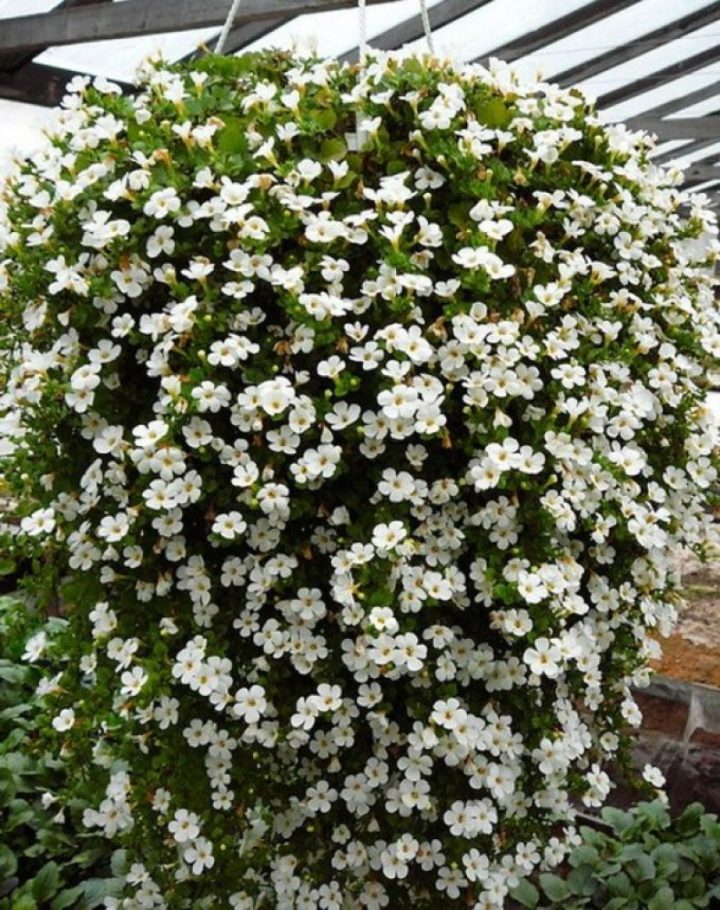
Among the most famous and popular are the following varieties:
A very unpretentious, but unusually beautiful plant with small five-petal white flowers. Stems up to 0.6 m long are covered with small round leaves. At the peak of flowering, the plant bears a clear resemblance to a lush ball. It is used for single cultivation in pots and baskets, as well as for creating various compositions with other flower crops. Not very fond of direct sunlight, preferring partial shade.
Bacopa Karolinska
... A small plant no more than 30 cm tall, bred in the eastern United States. This flower has straight, thick stems, which are planted with small oval leaves sitting in pairs. In the shade, the leaf blades are light green, and in direct sunlight, the color changes to copper-red. Small bright blue flowers are located at the very ends of the shoots. For the most part, this variety is bred as an aquarium. In the gardens she is seated on edges and shallow waters of natural or artificial reservoirs.
Used as an ampelous plant. Long drooping shoots are almost entirely covered with bluish-lilac buds. Blooms for a very long time.
Bacopa Vasilisa
... The drooping branches reach 0.3-0.6 m in length. The plant can grow in partial shade and in full sun. Flowers of a rich pale purple hue. It is planted on flower beds, balconies and alpine slides. Looks very good in compositions with small roses, petunias, chrysanthemums and other flowers.
Bacopa Blutopia
... An annual flower with shoots up to 0.6 m. From the beginning of June to the end of September, it is covered with very small beautiful blue flowers. Used to decorate borders and flower beds. Feels good in hanging pots. The plant is demanding on lighting. With a lack of sunlight, it stretches out and stops blooming.
Bacopa Huge Snowflake
(Giant Snowflake). A fairly large and unpretentious variety with shoots up to 0.9-1 m. Leaves are small. Large white flowers are very close to each other. The plant looks very impressive in a hanging planter, as its branches are so densely covered with flowers that they resemble a white waterfall. Flowering continues for several months.
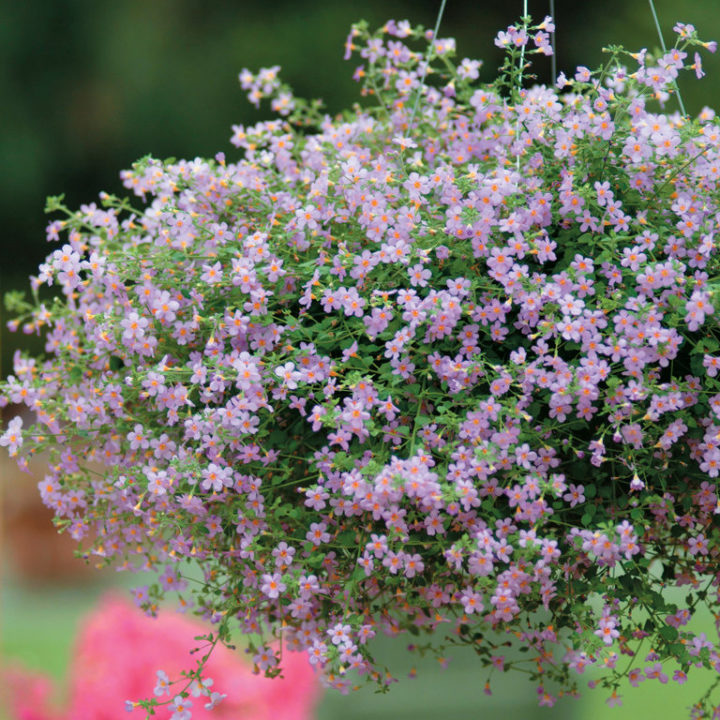
Bacopa ampelous has many varieties and hybrids of various shapes and colors. This allows you to choose plants for almost every taste.
Growing bacopa from seeds
Sowing Bacopa Seeds
For the primary cultivation of bacopa, you will have to resort to the seed method of reproduction. There are no special difficulties in growing bacopa from seeds, and it is not a problem to purchase high-quality seed in the store. When to sow bacopa for seedlings?
Sowing is carried out in March in peat substrate, sterilized for 4 hours in an oven at a temperature of 100 ºC, which, after cooling, is placed in a container with transparent walls. It is not necessary to deepen the seeds of bacopa, it is enough to press them to the surface of the moistened substrate and cover with foil or glass. Bacopa germinates from seeds in the light, at a temperature not lower than 20 ºC. Seedlings can appear in 10-14 days, and the full germination period can last 3-4 weeks.
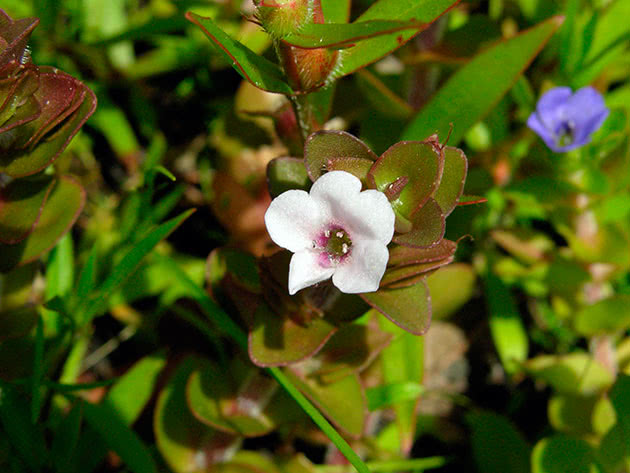
Bacopa seedling care
Caring for bacopa during the seedling period is simple
As soon as shoots begin to appear, it is important not to let the substrate dry out.
Remember to gently loosen the soil around the seedlings. At the stage of development in seedlings of three true leaves, the first picking of bacopa is carried out - transplanting seedlings into separate peat pots with a diameter of 5 cm
After the seedlings settle in a new place, they are fed with a complex mineral fertilizer in a half of the dose recommended by manufacturers. The optimum temperature for growing bacopa seedlings is 22-26 ºC
At the stage of development in seedlings of three true leaves, the first picking of bacopa is carried out - transplanting the seedlings into separate peat pots with a diameter of 5 cm.After the seedlings settle in a new place, they are fed with complex mineral fertilizer at half the dose recommended by manufacturers. The optimum temperature for growing bacopa seedlings is 22-26 ºC.
If you are going to plant seedlings in the garden, then, most likely, the bacopa seedlings will require a second pick - transplanting into larger pots, which for the stability of the seedlings is carried out with the stem deepening by one node. A week after the second pick, when the bacopa seedlings take root, they are fed with a complete mineral fertilizer with a predominance of phosphorus and nitrogen, after which the temperature in the room during the daytime is kept within 15-24 ºC, and at night - about 13-15 ºC.
If you grow Bacopa as a houseplant, then you do not need to make a second pick - the seedlings are immediately transplanted into a pots or basket.
Reproduction
Bacopa is easy to propagate. A new plant can be obtained from seeds, cuttings or layering.
There are general rules for growing seedlings that you need to consider:
Seedlings of Bacopa, unlike an adult bush, do not like direct sunlight
Abundant light can kill young seedlings.
The soil should be constantly moist, but without water accumulation in the bottom of the pot.
When growing in a greenhouse - under film, glass, it is important to accustom the plant to home conditions. In the future, with active growth, young bushes need to be taken out into the open air.
Without hardening, the plant will die after transplanting.
Bacopa should be planted in open ground or taken out in a pots in the open air no earlier than mid-May. A decrease in temperature or frost on the ground is detrimental to the delicate root system.
During rooting and sowing, it is important to keep the soil temperature in the pot at 20 degrees. It is a thermophilic plant.
Bacopa - growing from seed
It's important to know! Growing bacopa from seeds should be started in March. Seed germination is quite high, problems often occur during further care of the sprouts
To grow a healthy and beautiful plant from bacopa seeds, you need:
- Mix peat and sand in equal parts as a soil.
- Seeds should be sown by pressing slightly into the moistened soil.
- Cover the bowl with foil or glass.
- Place in a warm place in diffused light.
The seeds wake up after 14 days. Seeds fully germinate in four weeks.
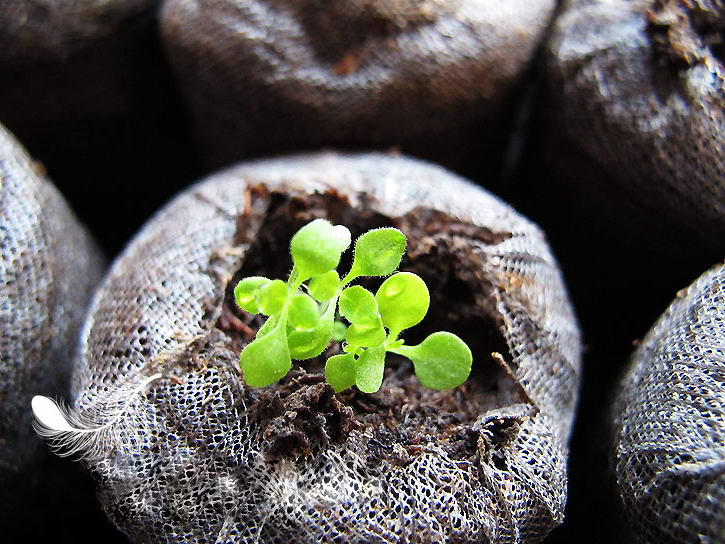
Growing bacopa from seeds in peat pots
At this time, it is important to keep the temperature at least 23 ° C and to moisten the soil. Top dressing must be done with diluted organic and mineral fertilizers alternately
Cuttings
The most favorable period for the propagation of Bakopa is in the summer - the end of August, for the winter procedure - January-April.

Cultivation of bacopa by cuttings requires preparation of material for planting.
Shoots can be divided into several parts, they will take root well. There should be at least two nodules on the cuttings - one will be the rudiment of the roots, the other - the leaves and shoots.
- On cut cuttings, you need to remove flowers and unopened buds, lower leaves.
- For more confident rooting, the tips of the cuttings are treated with root roots.
- Root in a wet mixture of sand and peat by immersing the bottom knot in the ground.
- Cover with foil or glass on top.
Cuttings take root quickly, after two weeks it is possible to assess the growth of the root system. Heat not lower than 23 degrees, light and moisture - all that is needed for successful cuttings
It is important not to forget to fertilize the cuttings with diluted organic matter and mineral feed, to harden the seedlings
It's important to know! After the appearance of 2-3 pairs of leaves, pinch the shoot to get a lush and branched bush

The active growth of new leaves and shoots with flowers suggests that the propagation of bacopa by cuttings was successful and the seedlings are ready for planting in open ground or in pots.
Layers
This is the fastest and most reliable method of producing a healthy and already flowering young plant.
During the active growth of the shoots, a pot with nutritious moist soil is placed next to the mother plant. Layers just need to be placed on top of the soil and secured with a metal or plastic pin.
Checking periodically for roots, loosen the soil in a new pot and moisten it. After the appearance of new shoots or a noticeable growth of the rooted one, the cuttings can be split off from the mother bush.
The method is good in that the sprouts grow much faster due to the supply of the maternal branch. And also a young bush grows immediately in the conditions of an adult flower and does not require additional fertilization or hardening. It can be grown by layering from the beginning of the active growth of shoots.
Breeding bacopa: 3 important secrets
It can be propagated in three ways: by cuttings, layering, or grown from seeds.
Layers
The easiest way to get new plants is to cut them.
You can do this throughout the growing season. If the bush grows in a flowerpot, it must be placed on the table. Take a few small cups filled with soil. Long lashes in places of future contact with the soil - to clear of leaves. Put one stalk in each glass. Before that, make a small depression in the ground, fix the stem in the ground with a hairpin and sprinkle it again. For the fastest rooting, you need to provide good lighting, the temperature is not lower than 20 degrees. and regular watering. Eating from the mother liquor, lateral shoots quickly release young roots.
It is possible to separate it from the mother plant when new young leaves begin to form on the "tail". This usually happens after one and a half to two weeks. Further care - as for a full-fledged, albeit still very small, plant. When the root system has grown enough, transfer to a large container is necessary. And so that the bush grows lush and more flowers form on it, the tips of the shoots above every fourth bud should be pinched.
Cuttings
Cutting Bacopa is best done at the end of winter, during the pruning period of the mother plant.
In order for the plant to please with flowering next year, the mother bush can be saved: transferred to the windowsill for the winter (preferably south or southeast orientation). The plant will not feel as good as in the bright sunlight in summer, the twigs will become thinner, the leaves will be crushed, but in general, with proper care, it will overwinter normally. To bring it into a decorative form, it should be cut off in late February or early March. It is necessary to remove all overgrown branches that are too thinned, on which smallish leaves have formed in winter with insufficient light.
After pruning, the mother plant must be watered well, and a little time later, fertilize and put on the lightest window sill in the house.
Cut branches - shorten, leave 2-4 pairs of leaves on them. Clean the bottom of the foliage, dip it in Kornevin powder and plant in a light, nutritious, fertile soil.
Regular watering, feeding, transferring to larger pots - and by mid-June you will have gorgeous full-fledged plants.
Seeds
It is better to sow seeds no earlier than mid-late March, so that the seedlings do not stretch out. Otherwise, they will have to be illuminated.
Buying bacopa seeds in stores lately is not a problem
It is important to pay attention to the shelf life: if it comes to an end, there is a risk of not waiting for the sprouts to appear
Before sowing, the seeds should be soaked in stimulants - "HB-101", "Ecosile" or others. The dosage of the aqueous solution and the soaking time should be strictly observed according to the instructions attached to the preparation.
The best soil for sowing is loose, moisture-absorbing and breathable. Seedling (crumbly, not consisting of solid peat!) From the store will do. You can prepare in advance: mix compost or humus earth with sand large fraction. The earth (even bought in a store) must be disinfected, at least spilled with boiling water with potassium permanganate crystals dissolved in it.
Spread the seeds over the surface of the soil (they are small enough) and sprinkle about 0.3 cm. Sprinkle with water from a spray bottle and for the first time create the effect of a mini-greenhouse: cover with a plastic bag. The package needs to be opened twice a day, the crops should be ventilated.
Seedlings will appear in a couple of weeks. Germination is uneven and can take almost a month.
It is better to dive with the appearance of 4 real leaves... As the seedlings grow, they are transferred into large containers 3-4 times.
After the first pick - the first feeding. Then they should be repeated every week. Both organic matter and mineral fertilizers for flower plants are suitable. Seedlings are fed at half the dose recommended for adult flowers.
Video: Bacopa, growing from seed
Types and varieties
There are over 60 varieties of Bacopa that can be grown at home. Each of them needs different growing conditions. Conventionally, all the variety can be divided into several categories: these are aquatic varieties, succulents and ampelous plants.
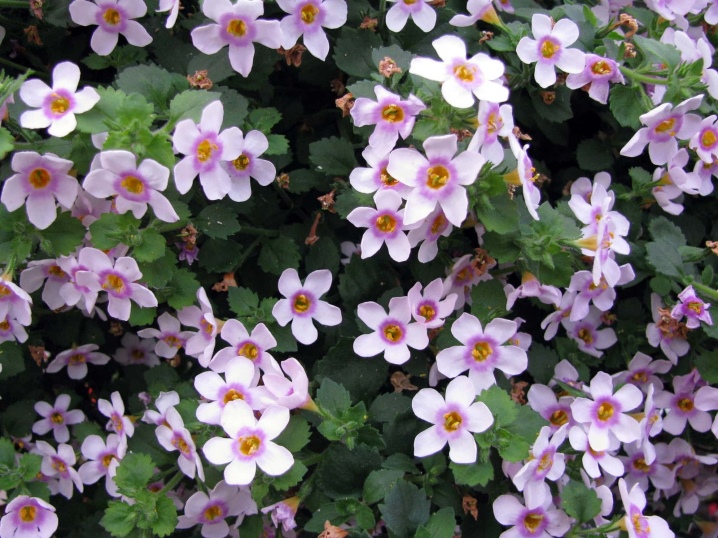
The crops that are cultivated in aquariums and artificial reservoirs include the following varieties.
Karolinska. This is a plant with thickened straight stems, oval paired leaves are located on them. As a rule, they are rigid and have an elongated oval shape. The height of such bush does not exceed 25-30 cm. Flowers are located at the very tips of the stems, have a deep blue tone. The color of the leaf plates makes the Caroline Bacopa especially attractive: in the rays of the sun, it changes its delicate green color to a deep reddish-red.
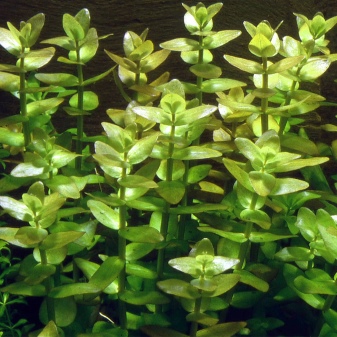
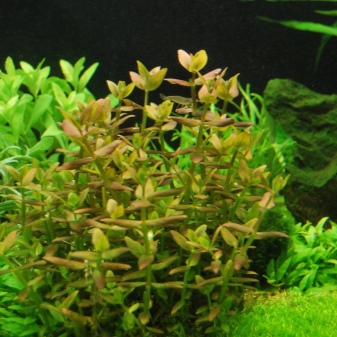
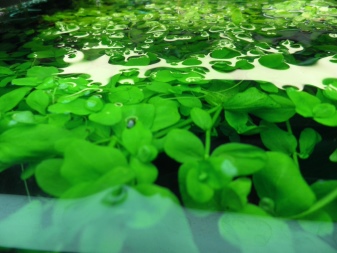
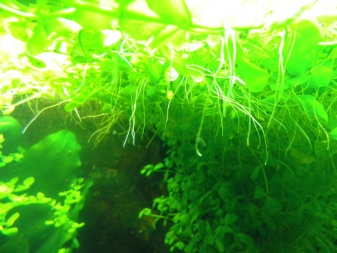





Popular types of bacopa for growing on balconies are the following.
Sprawling. This variety is better known as "beautiful". It is a large-flowered variety and forms a rather lush bush with elongated shoots up to 55-60 cm.The flower diameter is 2 mm, each has 5 petals growing from the axils of the leaves... Throughout the summer, as well as at the beginning of autumn, the bush is abundantly strewn with flowers of white, creamy, pink, and also blue shades. The spreading sutera is optimal for decorating individual compositions, as well as group plantings, looks spectacular in containers and pots - its hanging down or creeping stems cover it like a flower cloak.
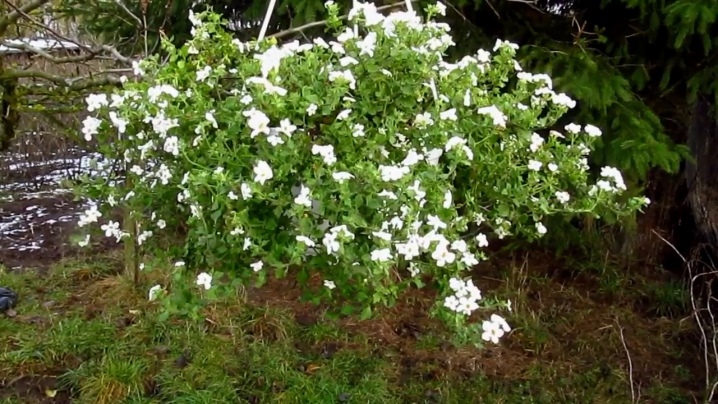
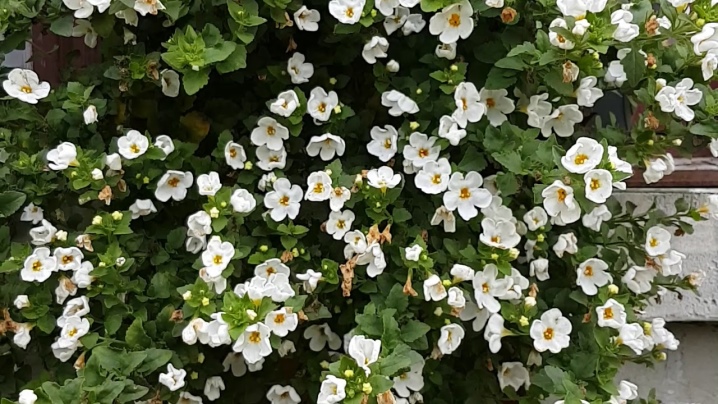
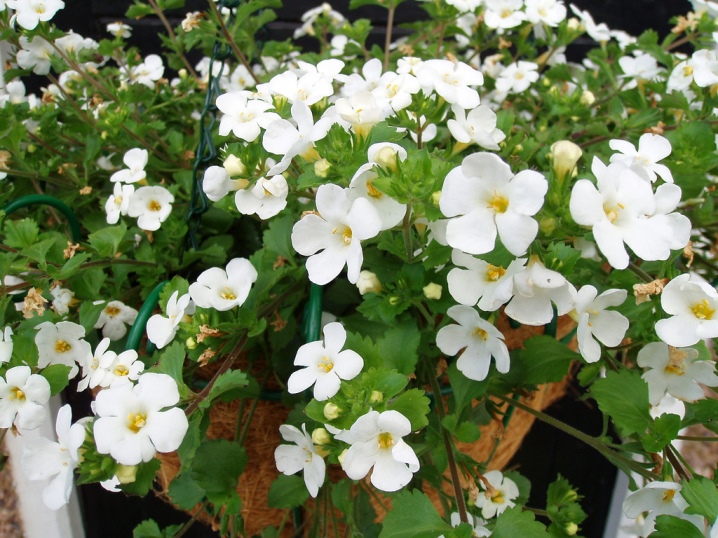
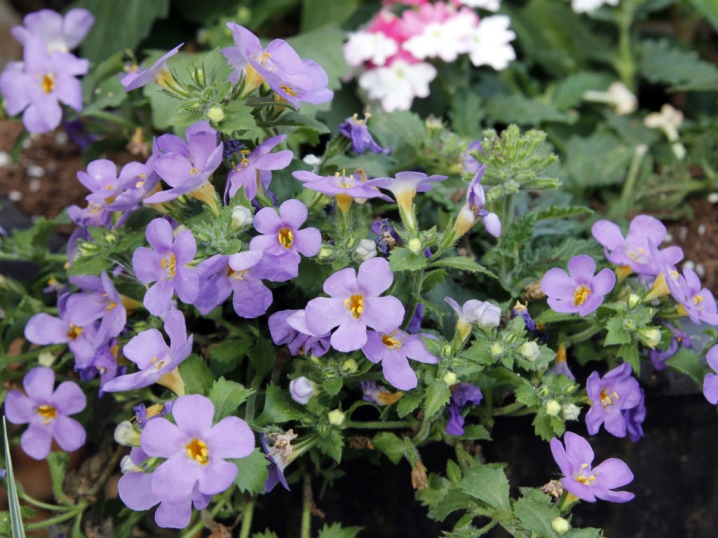
Basic requirements for caring for bacopa
This plant requires fairly easy care. It tolerates fluctuations in weather conditions well. For this reason, it is most often used for outdoor breeding.
We list the basic conditions for the successful cultivation of this native of exotic countries.
It hibernates in a cold room at a temperature of 10 to 15 degrees. Bacopa can survive occasional mild frosts. In summer, a not too hot temperature (up to 25 degrees) will be comfortable for her.
As for the light, you need a lot of it. Slight shading possible, direct sunlight is inadmissible.
It is better to choose a place for bacopa that is protected from the winds.
How to water? In winter, it is very rare and small. In the summer, especially in the heat, it is a lot and regularly.
Moist air is also needed. To do this, you can spray the plant and the air around on hot days.
The soil will need slightly acidified. The composition should make it light, porous, loose. Typically, the soil mixture includes layers of peat, sand and humus.
It is better to choose fertilizers in liquid form; a special complex of minerals, alternating with organic, is suitable. Top dressing is applied up to once every 10-14 days.
Pinching is done so that the bacopa grows bushy and lush. Removal of faded flowers is not required, they crumble themselves
After that, there is a temporary rest of the plant, and then a new burst of bud formation.
It is necessary to loosen the soil carefully, since the roots of these flowers lie close to the surface.
In order to enjoy colorful blooms every year, renew your flower. To do this, young shoots are separated from the mother and planted for separate growth.
It is not for nothing that Bacopa ampelous attracts the attention of gardeners. The use of this plant is suitable for decorating balconies and loggias, facades of country houses, screens and carpets spreading along the ground.
Even ponds can be decorated with these wonderful colors.
Let your imagination unfold, choose varieties and colors, combine bacopa with other plants, treat yourself to star blooming. The presence of these southern flowers will make your summer cottage an admiration for neighbors and guests.
My pot with balcony petunias at the beginning of summer, when the flowers do not yet have time to spread their shoots, seems to me empty. A neighbor recommended planting a couple of bacopa bushes here as well.
It turned out what we need: from above there are large and bright "lanterns" of petunias, from below the creeping shoots of this new for me ampelous plant, delicate, with creamy, extremely generous flowers. Highly recommend!
Bacopa (aka sutera) is a herbaceous curly perennial, a relative of the plantain. She was brought to us from the tropics of South Africa. At the same time, the plant is unpretentious and is suitable not only for open balconies, but also for flower beds.
There are a lot of types of flowers. Add to them a lot of varieties, hybrids ... In general, you have a place to roam.
The plant blooms for a long time. The flowers are small, but there are many of them.
This is how they look up close:

And here is the difference between Bacopa and Petunia:
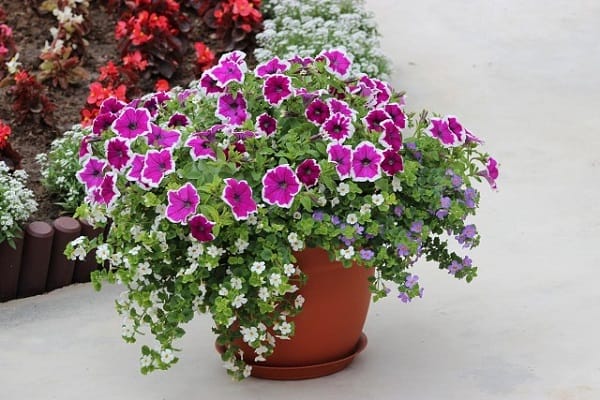
Which variety to choose?
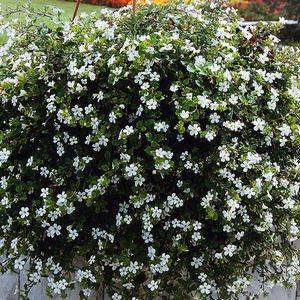 The variety of uses of this elegant universal plant is complemented by the variety of its varieties, each of which is most suitable for certain design solutions.
The variety of uses of this elegant universal plant is complemented by the variety of its varieties, each of which is most suitable for certain design solutions.
- The varieties Snowflake and Boar, which have especially large flowers, will create a festive atmosphere on the terrace or balcony.
- The abundantly blooming snow-white variety Snowtopia will create a feeling of freshness and lightness in a semi-shaded interior.
- Bacopa Karolinska is considered ideal for decorating aquariums and reservoirs.
- Rosea and Pink Domino varieties with pink and purple flowers add tenderness to the intimate corners of the garden.
- Blue Shaues with long shoots is a good solution for creating a flower screen.
- Bacopa Monnier can not only serve as a decoration of the site, but also be used as a medicinal plant.
- Variety African Sunset with the brightness of scarlet flowers will turn a hanging flowerpot into a kind of shining lamp.
Planting and leaving
Caring for and growing a pimp is not difficult. It easily tolerates temperature fluctuations and various weather conditions. The basic principles of its content are as follows:
The most comfortable temperature in summer will be around 25 ° C. The plant does not like too much heat. The winter temperature should be kept around + 10 ... + 15 ° C, therefore, in the cold season, flowerpots are brought into the room or the flowers are dug out. Although they can survive occasional short-term frosts (down to -5 ° C).
This flower feels best in well-lit places, but it also tolerates light shading.
The planting site must be protected from the winds.
Watering is required regularly and plentiful, especially in summer. Usually watered in the morning and after sunset.
In the first phase of the growing season, when the plant is actively increasing its green mass, it needs daily spraying (3-4 times a day). As soon as flowering begins, the procedures are stopped.
The soil for planting this crop requires a slightly acidic or neutral reaction. It should be loose and light. The substrate is made up of humus, garden soil, peat and sand.
Top dressing is carried out 1 time in 7-10 days, using special mineral complexes for flowering plants. They are alternated with organic feedings.
To form a lush and bushy crown, the flower must be pinched regularly. When the shoots reach a certain length (usually no more than 0.6 m), they are shortened. If this is not done, the branches will become elongated and bare.
Due to the superficial location of the root system, loosening must be done very carefully and carefully. When disembarking, the bacopa can be slightly deepened
She will give adventitious roots and take root better
When disembarking, the bacopa can be slightly deepened. It will give adventitious roots and take root better.

Although this plant is perennial, with age it loses its decorative effect and requires renewal. A very big plus of the suter is the absence of the need to remove faded flowers. They fall off by themselves. After a short break, the flower is again covered with buds.
Bacopa flower
Bacopa inhabits the humid marshlands of the tropics of America, Africa and Australia. Her love for moisture remained in the conditions of ornamental cultivation. Bright sunlight is needed for its abundant flowering, and moist soil for active growth of shoots.

Bacopa pink
Small flowers cover the entire length of the shoots, which can grow up to meters. Flowers of light delicate shades - white, lilac, blue, purple, pink. Green or olive leaves are small, growing in pairs. Bacopa belongs to the plantain family.
Interesting to know! Other names for the plant are Vasora or Sutera.
The green beauty grows well both outdoors and indoors - on balconies and verandas all summer long. The plant is unpretentious, active and healthy growth is supported by compliance with just a few conditions:
The lighting should be plentiful, the flower should receive a daily dose of direct sunlight. It should be planted in open ground in sunny and unshaded areas. Balconies and loggias also need good lighting.
Abundant watering, but the soil should pass water well and not retain moisture in the roots of the flower. The soil in the pot must be constantly moist.
For root breathing, it is important to loosen the soil after each watering, both in a pot and in a flower bed.
Fertilization is necessary when a flower is propagated in order for the roots to grow stronger during the period of active growth of greenery.
The only requirement for the soil is looseness and airiness. It must pass moisture and air well.
It's important to know! With a lack of light, Bacopa will not bloom, although it will grow. Many flower lovers are unknowingly waiting
Diseases and pests, with proper care, practically do not affect the flower. Most often, the plant gets sick during wintering in room conditions, when the earthen coma is allowed to dry out, the temperature rises or the humidity level decreases.
Description of Bacopa
Delicate and romantic bacopa (sutera) is such an exquisite and sophisticated plant that it will become a source of pride for its owner. She will be a worthy inhabitant of a balcony, loggia, veranda, gazebo, cover fences and walls with a blooming cloud, make good friends with a chrysanthemum, low rose, petunia, fuchsia, or serve as an annual ground cover for alpine slides. This ampelous flower has creeping shoots 40-60 cm long with emerald leaves; it is abundantly strewn with miniature star flowers. She has a rich color palette: purple, pink, blue, red, white flowers. It is believed that the white shade is the most stable and unpretentious. Sutera blooms almost all season, from early spring to autumn, without fear of rainy weather.
This ampelous flower has creeping shoots 40-60 cm long with emerald leaves; it is abundantly strewn with miniature star flowers. She has a rich color palette: purple, pink, blue, red, white flowers. It is believed that the white shade is the most stable and unpretentious. Sutera blooms almost all season, from early spring to autumn, without fear of rainy weather.
Caring for bacopa at home
How to care for Bacopa at home
The conditions for growing bacopa in an apartment are not much different from those in the garden. How to grow Bacopa indoors?
The plant is planted in a substrate of approximately the following composition: humus, sand, garden soil and peat in a ratio of 2: 2: 1: 1. The soil for the ampelous bacopa should prevent waterlogging, since the fragile roots of the plant are prone to decay, and that is why a thick layer of drainage material must be placed in the pot. Watering home bacopa, like gardening, should be frequent and abundant, avoiding, however, prolonged and chronic waterlogging of the soil, since this is much more dangerous than rare and insufficient moisture
After watering, the soil in the pots must be carefully loosened. Once every 10-14 days, a liquid mineral fertilizer for flowering plants is added to the water for irrigation, so that the greens of the bacopa are always juicy and bright, and the flowering is abundant
The fertilizer solution is poured under the root, trying not to get on the leaves of the plant.
Bacopa placement
Bacopa at home, as well as in the garden, requires good lighting and some direct sunlight daily. It grows well in partial shade, but by placing it away from the light, you may not wait to bloom. Since the plant normally tolerates temperature extremes and even frosts down to -5 ºC, bacopa in pots from spring to late autumn can decorate a balcony, terrace, veranda or loggia.

Pruning Bacopa
In order for Bacopa to bush well, the ends of its shoots are pinched from time to time, and if the lashes of the plant become too long, they are cut off. The apical cuttings remaining after pruning are used for propagation. Bacopa is also cut off when the lower part of its shoots begins to lignify, and flowering becomes scarce. In this case, the shoots are shortened by a third of the length, and it is better to do such pruning in the fall.
Bacopa pests and diseases
With improper care or non-compliance with growing conditions, bacopa can be affected by gray rot, soot or mold, especially if planting too densely. If bacopa is damaged by fungi, its crown must be thinned out, and then the plant must be treated two or three times with a solution of a fungicidal preparation at intervals of two weeks.
Bacopa pests include whiteflies, aphids and spider mites. All these insects are sucking, that is, they feed on the cell sap of the bacopa, so they can be destroyed with acaricidal preparations in two or three stages.
Reproduction of bacopa
Bacopa propagates by seeds as well as cuttings.To get cuttings, you need to cut off the upper part of the shoot. Rooting time is from January to March, or from August to September.
Bacopa cuttings are rooted in a light substrate.
The container with bacopa cuttings can be placed in a greenhouse or covered with a plastic bag. When the plant takes root and begins to grow, you need to pinch the top so that the bacopa bushes and forms side shoots.
The experience of florists has shown that the percentage of rooted cuttings in ampelous bacopa with white flowers is high. The snow-white varieties of Bacopa are highly resistant to disease. Cuttings are planted in May.
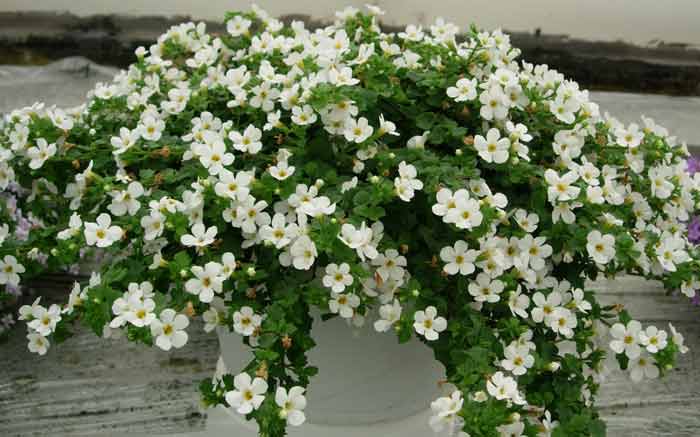
When growing bacopa from seeds, they must be sown on seedlings.
Sowing should be shallow, only pressing the seeds to light soil.
After sowing, the container must be placed in a room with a temperature of at least 18 ° C and high humidity. The best temperature is 20-24 ° C warm. Seedlings appear two weeks after sowing.
A pick is made when several real leaves appear. Dive in the distance not less than 2 cm between plants.

The second pick is made in separate cups or pots with a drainage hole. After the second pick, you can feed with mineral fertilizers.
After the second pick, the seedlings are hardened. The growing temperature decreases, it should be about + 15-23 ° C.

